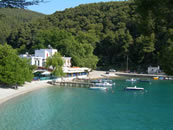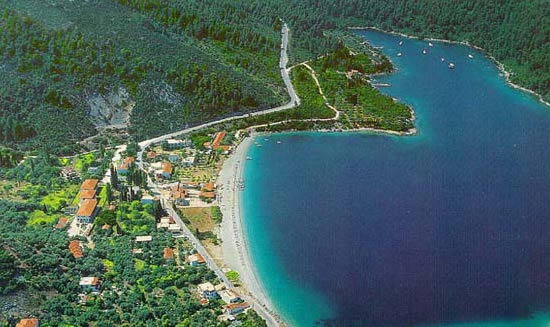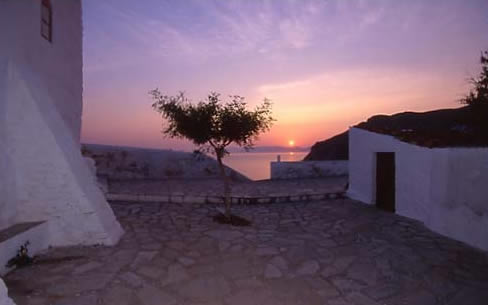 Skopelos is the second most developed tourist destination of the Sporades and one of the greenest islands in the Aegean Sea.
The island is virtually full of pine forests that make it ideal for walking and hiking.
That's why Skopelos was officially nominated in 1997 as “The Green and Blue Island” from the BIOPOLITICS INTERNATIONAL ORGANISATION (B.I.O.)
Skopelos is the second most developed tourist destination of the Sporades and one of the greenest islands in the Aegean Sea.
The island is virtually full of pine forests that make it ideal for walking and hiking.
That's why Skopelos was officially nominated in 1997 as “The Green and Blue Island” from the BIOPOLITICS INTERNATIONAL ORGANISATION (B.I.O.)
The island is located east of mainland Greece, northeast of the island of Euboea and is part of the Prefecture of Magnesias in the Periphery of Thessaly.
The nearest inhabited islands are Skiathos to the west and Alonissos to the east. With an area of 95 km², Skopelos is the largest island of the Sporades group of islands.
Soaring mountains, verdant pine forests, sparkling clear seas and wonderful beaches make this island a real paradise on earth.
In 1978 the town of Skopelos was honored by President of Greece Konstantinos Tsatsos as a Traditional Settlement of Outstanding Beauty.
This is the Greek equivalent of a site of Outstanding Architectural Inheritance.
Skopelos is also famous of its enchanting view when you are entering the harbour, the 380(!) churches, the white painted houses and the narrow paved alleys.
It is a traditional island known for its relaxed atmosphere.

Communities and Settlements in Skopelos
Hora (Skopelos Town)
The capital and main port for the island. A charming little town with its white-washed houses, red tiled roofs,
flowered gardens and balconies. Its many little white churches,narrow streets, alleyways, and climbing stairs,
all built on a hillside in the heart of a bay. Set against a backdrop of spectacular views of the forest covered
mountains tumbling down to the clean beaches and unpolluted azure seas.
Glossa
The second main town of Skopelos is a picturesque village of 1,200 people with a stunning position high over the sea.
There are ruins in GLOSSA dating from 400 BC as well as Byzantine walls to poke about in.
The traditional village way of life has so far managed to stand fast against the annual and ever growing influx of
visitors and the place oozes charm, unlike the drab port of Loutraki below. The houses are mostly two storey with wooden
balconies and the fields are full of plum and almond trees.Other roads lead to deserted beaches at Spelia, Mavraki, Keramoto and Chontrogeorgi.
Neo Klima (Elios)
 "Eleos" means "mercy" and ELIOS is where the island's patron
saint Reginus is believed to have delivered his flock from a fearsome dragon. The beach is pleasant enough but this part of the island is intermittently affected by deep earthly rumblings.
The unsightly village was slapped up after the 1965 earthquake dislodged the hillside village of old KLIMA.
The village has plenty of tavernas and mini markets. There are also many sand and shingle coves along the coast,
most notably the beach at HOLVOLO though access is difficult from the SW end of Elios beach.
"Eleos" means "mercy" and ELIOS is where the island's patron
saint Reginus is believed to have delivered his flock from a fearsome dragon. The beach is pleasant enough but this part of the island is intermittently affected by deep earthly rumblings.
The unsightly village was slapped up after the 1965 earthquake dislodged the hillside village of old KLIMA.
The village has plenty of tavernas and mini markets. There are also many sand and shingle coves along the coast,
most notably the beach at HOLVOLO though access is difficult from the SW end of Elios beach.
Agnondas
A nice little bay and pleasant fishing harbour at AGNONDAS is enclosed by hills of lush pine forest.
Several shoreline tavernas back onto the beach providing good food, especially fresh fish, and they make the place
a pleasant spot for that seashore meal.
Loutraki
Loutraki is the second port in Skopelos. Ferries and flying dolphins stop for Glossa. The bus route starts from here via Glossa to Skopelos Town. Fishing boats and yachts dock in its small and pretty harbour. This quiet traditional harbour of small winding streets has some good restaurants. Spend a relaxing afternoon, watch the sunset and enjoy a glass of wine - or two!
Beaches of Skopelos
Velanio
 This lovely beach at VELANIO used to be a favourite with nudists but they now tend to stay at the far northern end beyond a rocky outcrop and the beach is more public than pubic.
This lovely beach at VELANIO used to be a favourite with nudists but they now tend to stay at the far northern end beyond a rocky outcrop and the beach is more public than pubic.
The bay is wide and the beach bigger and steeper than the neighbouring (and more popular) Stafylos. It is a mixture of sand and shingle and, the further along the beach you go, the sandier it gets. The waters here are very clean and clear, ideal for swimming.
Lines of sun beds occupy the more popular end of the beach; naturists must make do with their straw mats.
The resort is said to take its name from old Roman baths 'valaneia' that were once reputedly sited here but locals say 'venanio' simply means acorn and dismiss the Roman link. There is a spring near the end of the beach but you must pick your way through the naturists to get to it.
Stafylos
The island's main beach at STAFYLOS or STAFILOS is popular with families, but only because it is the nearest to Skopelos town - about 4km. It lies just around a rather impressive headland from Velanio. Access is off the main road, 500m down a dirt track with some stone steps. The narrow strip of sand and shingle is attractive enough - basking beneath steep and high scrub-covered cliffs with a small beach cantina at one end. Its popularity has grown recently and - if don't mind the noise and numbers - this is as pleasant a beach as any though the steep cliffs behind can seem oppressive, the narrow beach only allows for one or two rows of sun beds and the beach bar delights in playing loud music.

Panormos Bay
Situated on the sheltered southwest coast, is a beautiful and wind protected bay with coves and a natural boat harbour. Panormos is 12km from Skopelos Town on the main road to Glossa and is easy reached by local transport, so no long walks to the beach are required! Very popular and crowded with locals and tourists in season, it offers great variety with hotels, restaurants, taverns, and some shops in the bay area. Blue Flag Beach has sun beds, umbrellas, water sports and is mainly shingle.
Sares
Across the other side of the bay from Skopelos town is a narrow beach of stone and shingle backed by steep grey cliffs. SARES means steep and it is certainly is. A recent rock fall has made the beach virtually inaccessible unless you have a boat and there is not a lot when you get there - steep cliffs, stone and shingle. There are no facilities.

Worth Seeing on Skopelos
- The tomb of Staphylos, 4 km from the capital. Its rich treasure led archeologists to deduce the tomb was that of an ancient king. Today the treasure can be seen in the museum of the nearby city of Volos, on the opposite coast of Greece.
- The few remains of the temple of Asclipio (4th Century BC), on the beach, near the capital.
- The Venetian Castle of the city of Skopelos (13th Century), high above the capital, at the site of the ancient acropolis. Today very few ruins remain in place.
- The Ancient Tombs excavated in the rocks, at Sentoukia, in Mount Delphi. Due to their location, they can be reached only by foot.
-
Monasteries:

- The Monastery of Evanghelistria (18th Century), 4 km from the capital, in a beautiful place, with very valuable icons.
- The Monastery of Agia Varvara, 5 km from the capital, with a wonderful view of the sea.
- The Monastery of Timio Prodromos (17th Century), 6 km from the capital, with Byzantine icons.
- The Monastery of Metamorphosi (1600), near the capital.
For accommodation on Skopelos,
please click here to send us an e-mail with your request.
